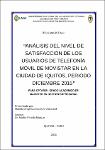| dc.contributor.advisor | Pinedo Manzur, Freddy Martín | |
| dc.contributor.author | Zevallos Valcárcel, Mariela Angélica | |
| dc.date.accessioned | 2017-02-27T19:00:53Z | |
| dc.date.available | 2017-02-27T19:00:53Z | |
| dc.date.issued | 2016 | |
| dc.identifier.uri | http://repositorio.unapiquitos.edu.pe/handle/20.500.12737/4193 | |
| dc.description.abstract | El crecimiento exponencial de la telefonía móvil en el Perú ha permitido pasar de 9 millones de líneas en el año 2006 a poco más de 31 millones 680 mil de líneas móviles a diciembre del 2014. La cobertura de telefonía móvil en los distritos del Perú se ha triplicado, pues hace más de cinco años sólo 433 distritos eran atendidos. El año pasado cerró con la hegemonía de Movistar (54.4%) y Claro (39.6%) en la telefonía móvil. Pero las nuevas operadoras empiezan a asomar alcanzando juntas un 6.4% del mercado de 31 millones 680 mil líneas. En 2014 se registraron 1 millón 910 mil nuevas líneas en el país, lo que representó un 6% más que el año anterior, informó el Organismo Supervisor de la Inversión Privada en Telecomunicaciones (Osiptel). Movistar tiene la mayor parte de los usuarios Prepago y Control, mientras que Claro se lleva la mayor parte de las líneas Postpago. Entel y Bitel ven mayor participación en las líneas Control, consiguiendo la primera el 20.3% de este mercado. El nivel de competencia en el mercado peruano ha dado un gran salto con el ingreso de un cuarto operador móvil competidor; que agiliza aún más el mercado de las telecomunicaciones. Las nuevas regulaciones establecidas por Organismo de Supervisión de la Inversión Privada en Telecomunicaciones (OSIPTEL) buscan promover la competencia, especialmente en la prestación de servicios a usuarios de teléfonos móviles. Hasta el año 2013 los únicos operadores móviles que ofrecían servicios en la ciudad de Iquitos eran las empresas Movistar y Claro. Desde Octubre del 2014 empezó a operar la empresa vietnamita Bitel Perú, y en el 2015 ingresó Entel. Pero, como ya se dijo anteriormente, el operador que concentra más del 50% de usuarios es Movistar; por ello resulta necesario investigar el grado de satisfacción de los usuarios para corregir los errores y tratar de mantenerles como clientes de manera prolongada. La estructura de esta investigación muestra total coherencia entre un capítulo y otro con la finalidad de demostrar la Hipótesis General planteada, así como las Hipótesis Específicas. Luego, se estudian los datos y se validan las Hipótesis para, posteriormente, arribar a las Conclusiones y Recomendaciones, en los respectivos capítulos que conforman la presente investigación. | es_PE |
| dc.description.abstract | The exponential growth of mobile telephony in Peru has allowed passing 9 million lines in 2006 to just over 31 million mobile lines 680,000 to December 2014. The mobile phone coverage in the districts of Peru has triplicate, for more than five years only 433 districts were catered ago. Last year ended with the hegemony of Movistar (54.4%) and Claro (39.6%) in mobile telephony. But new operators beginning to come together reaching 6.4% of the market of 31 million 680 thousand lines. In 2014 they recorded 1 million 910 thousand new lines in the country, representing a 6% increase over the previous year, the Supervisory Agency for Private Investment in Telecommunications (Osiptel) reported. Movistar has most of the Prepaid users and Control, while Claro most of the Postpaid lines takes. Entel and Bitel see greater participation in the control lines, achieving the first 20.3% of this market. The level of competition in the Peruvian market has taken a big leap with the entry of a fourth mobile operator competitor; which further streamlines the telecommunications market. The new regulations established by the Supervisory Body of Private Investment in Telecommunications (Osiptel) seek to promote competition, especially in providing services to mobile phone users. Until 2013, the unique mobile operators offering services in the city of Iquitos were companies Movistar and Claro. Since October 2014 began operating the Vietnamese company Bitel Peru, and in 2015 entered Entel. But, as noted above, the operator concentrates more than 50% of users Movistar; It is therefore necessary to determine the degree of satisfaction of users to correct errors and try to keep them as customers long way. The structure of this research shows complete consistency between one chapter and another in order to prove the hypothesis General and specific assumptions. Then the data are studied and assumptions to be validated then arrive at the conclusions and recommendations in the respective chapters of this investigation. | en_US |
| dc.description.uri | Tesis | es_PE |
| dc.format | application/pdf | es_PE |
| dc.language.iso | spa | es_PE |
| dc.publisher | Universidad Nacional de la Amazonía Peruana | es_PE |
| dc.rights | info:eu-repo/semantics/openAccess | es_PE |
| dc.rights | Attribution-NonCommercial-NoDerivs 3.0 United States | * |
| dc.rights.uri | http://creativecommons.org/licenses/by-nc-nd/3.0/us/ | * |
| dc.source | Universidad Nacional de la Amazonía Peruana | es_PE |
| dc.source | Repositorio Institucional - UNAP | es_PE |
| dc.subject | Satisfacción del consumidor | es_PE |
| dc.subject | Empresas de telecomunicaciones | es_PE |
| dc.subject | Teléfono móvil | es_PE |
| dc.title | Análisis del nivel de satisfacción de los usuarios de telefonía móvil de Movistar en la ciudad de Iquitos, periodo diciembre 2015 | es_PE |
| dc.type | info:eu-repo/semantics/masterThesis | es_PE |
| thesis.degree.discipline | Ciencias Económicas y de Negocios | es_PE |
| thesis.degree.grantor | Universidad Nacional de la Amazonía Peruana. Escuela de Posgrado | es_PE |
| thesis.degree.level | Maestría | es_PE |
| thesis.degree.name | Magister en Gestión Empresarial | es_PE |
| thesis.degree.program | Regular | es_PE |


